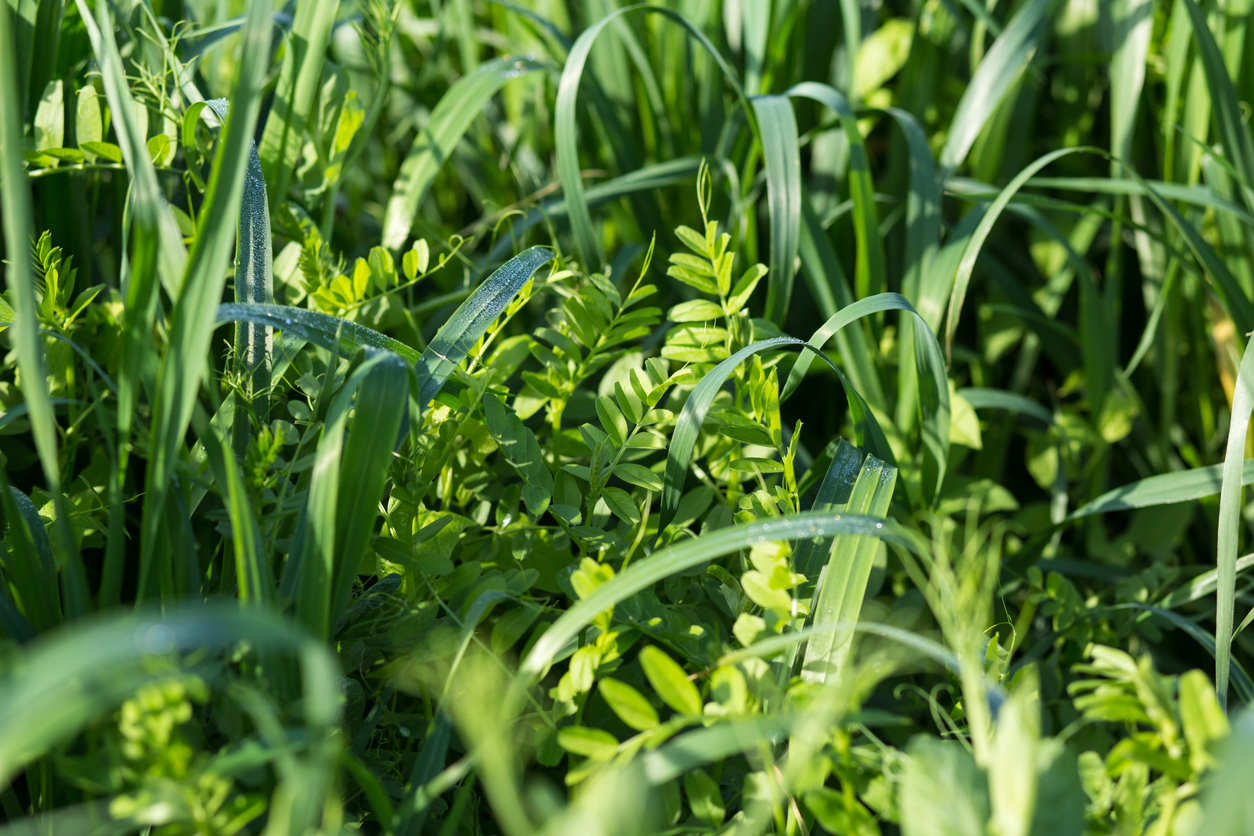Forage Cover Crops
Planting forage cover crops can be a beneficial food source and a place to apply manure. Grass cover crops like sorghum, Sudan, Sorghum-Sudan, cereal rye, annual ryegrass, millets, Teff, and oats are great forages that build organic matter, tie up manure nutrients, keep the soil from eroding, improve soil structure and still make great feed. Adding legumes like Balansa or crimson clover, winter peas, or vetches can increase crude protein (CP). Kale, radish, or turnips may be added at low seeding rates if the cover crop is grazed.
Sorghum or Sudan hybrids are summer annual grasses that grow with little moisture and provide great tonnage. Deep fibrous roots break up soil compaction and add soil organic matter. Plant these varieties immediately after wheat or barley harvest and take an early first cutting or graze when the plants are 3-4 feet tall. Harvesting stimulates roots and tillering, adding 5-10X more roots and shoots. Manure increase the second and possibly third cutting before frost kills the plant. Cowpeas (takes very little moisture and does well in hot summers) or winter peas (likes cooler and wetter summers) can be added to improve protein content. Sorghum or Sudan planting forage rates vary but drill 30-35#/A pure live seed (PLS) minimum at .5-1.5 inches deep or to moisture. Cover crop forage seeding rates are generally higher than normal seeding rates.
Cereal rye and annual ryegrass should be planted around the August 1st. They can be planted earlier but may not thrive or grow until temperatures cool off and there is adequate moisture. Cereal rye is often planted after corn silage at forage seeding rates of 2-3 bushel PLS per acre drilled .75-1.5 inches deep to moisture. Annual rye can be drilled at 18-20#/A PLS and .25-0.5 inches deep. Both crops are winter annuals that can harvested in the Spring (first part of May) and then planted back to corn or soybeans. Annual ryegrass needs to be harvested as haylage or wrapped, because the plant stem will not dry and will mold. Both make excellent feed for beef cows or all types of dairy cattle. Manure can be applied to cereal rye or annual ryegrass pre-plant or after the crop emerges (2-4 inches tall). Adding manure in the fall yields CP up to 12%, another application in the spring may increase yields and CP up to 18%.
Other forage grass cover crops include millets (pearl or fox), Teff, and oats. Millets like pearl and fox are good for hot dry summers but do not tolerate shade or ponding water. Drill the millets 15#/A PLS at a depth of .5 to 1.0 inches. Teff is like timothy and grows well with little moisture and warm temperatures but also responds well to manure. Teff can be planted at 4- 8#/A PLS with a Brillion seeder at .125-.25 inches deep. Pearl, fox millets, and Teff are summer annual that die with the first frost.
Oats is hardier in the fall but does better planted late summer. Forage oats have a larger leaf, higher forage quality, but is more expensive. Winter oats also has a larger leaf and may survive most winters. Spring or common oats are inexpensive but should be cleaned of weed seed before planting. Oats are highly mycorrhizal, very sweet, and great for improving soil structure and promoting soil health. Oats should be drilled at 2-3 bushel/A PLS as a forage .5 to 1.5 inches deep. Wheat is a poor cover crop or forage because it harbors some of the same diseases as corn. Broadcasting any forage cover crop seed (increase seeding rate 10%) can be done before a good rain but without rain, germination may be delayed.
Legume cover crops used as forages include red clover (tolerates wet soil, 8-10#), Balansa (4- 5#), crimson clover (10-20#), and vetches (hairy and common, 15-20#) should all be drilled no deeper than .25-.5 inches deep. Red clover and vetches are often planted in August while the clovers can be planted up to mid-September. Legumes and clovers are smaller seeded, more expensive, and not as good at scavenging manure nutrients, but provide higher quality forage than the grasses. Other cover crops that can be used in forages mixtures in small amounts include kale (very small seed, up to 21% CP), radish, and turnips. Forage cover crops are a profitable way to harvest more sunlight, keep the environment safe, and improve soil health.
